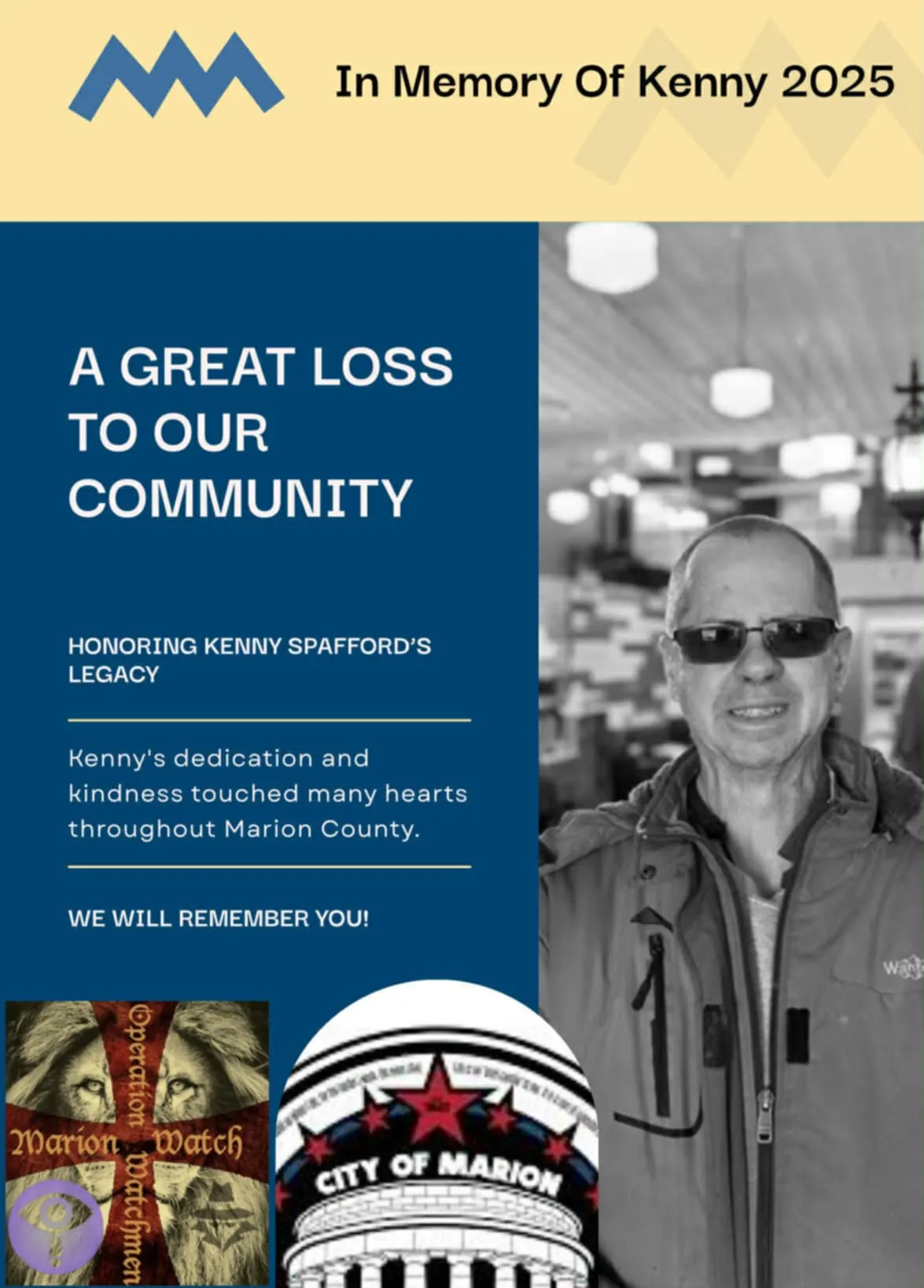It is with great sadness that the Marion Watch Teams have learned of the passing of hometown hero Kenny Spafford.

Kenny Spafford is a highly recognizable and cherished figure in Marion, Ohio, known for his extensive and dedicated community involvement. Honored as a “Hometown Hero,” his contributions span decades, encompassing formal volunteer roles, participation in numerous charity walks, and consistent personal acts of stewardship like daily litter collection. His deep connection to Marion, coupled with unique personal qualities such as an exceptional memory and a broad social network, have enabled him to foster strong community ties and inspire collective action, solidifying his role as an indispensable pillar of the Marion community.
Local social media has been inundated with reactions, and the news was shared with us several hours ago by our own Ed Mccants. Starting tomorrow, June 26th, 2025, Downtown Marion, Inc. will be placing donation jars to help with funeral and burial costs. A list of locations accepting donations will be posted tomorrow morning.
A Deep-Rooted Connection to Marion
Kenny Spafford’s profound connection to Marion, Ohio, began when he moved there at age 19 to attend Tri-Rivers, becoming a local fixture over the past 30 years (as of 2018). Originally from Lima, Ohio, his family background includes parents who were veterans, and he himself is a “huge military history buff”. He expresses deep gratitude for the community, stating, “Marion has been so kind to me,” and credits a “support network” for guiding him. Spafford works part-time at Goodwill and is self-employed, cleaning offices in downtown Marion, further embedding him in the local economy.
A Lifetime of Dedicated Service
Spafford is a “local fixture, volunteering for causes too numerous to count”. His formal volunteer efforts include significant involvement with organizations such as the Christmas Clearinghouse, Green Camp Lions Club, Marion County Board of Elections, Marion Relay for Life, the Palace Theatre, and the Miss Heart of Ohio Pageant.
Beyond structured roles, Spafford is a dedicated participant in charity walks, often motivated by his own battle with Type 2 diabetes. He has walked to support a wide array of health-related causes, including the March of Dimes, Race for the Cure, multiple sclerosis, cystic fibrosis, arthritis, pediatric cancer, leukemia & lymphoma, Special Olympics, diabetes, and the Kidney Association. A defining characteristic of his civic action is his daily commitment to the community’s well-being, as he is regularly seen “picking up litter on his daily walks” throughout Marion County. His consistent presence and dedication enable him to “rally support from others” for various causes.
Accolades and Recognition
Kenny Spafford’s profound contributions have earned him significant recognition within the Marion community.
In 2016, he received the prestigious Hometown Hero Award from Modern Woodmen of America for his “countless hours of service to the community”. The award was presented on March 23, 2016, and included a certificate and a $100 grant, which Spafford directed to the Miss Ohio Scholarship Program, Inc.. Jeff Reed, a local Modern Woodmen volunteer leader, emphasized that “Volunteers form the foundation of a strong community”.
Another unique recognition came from Harding High School, which awarded him its Presidential Citation as their “#1 Fan”. This honor acknowledges his consistent presence and enthusiastic support for local youth sports, as he diligently follows football, basketball, and volleyball at both Harding and Pleasant high schools, possessing an “incredible memory” for sports statistics.
The following table summarizes Kenny Spafford’s key awards and recognitions:
Key Awards and Recognitions of Kenny Spafford
| Award Name | Awarding Body | Year Received | Reason for Award / Specific Contribution Recognized | Associated Details |
|---|---|---|---|---|
| Hometown Hero Award | Modern Woodmen of America | 2016 | Countless hours of service to the community, including March of Dimes, Leukemia & Lymphoma Society, Special Olympics of Ohio, Marion County Board of Elections, Marion Relay for Life, and The Marion Palace Theatre. | Certificate and $100 award grant, which Spafford directed to the Miss Ohio Scholarship Program, Inc. |
| Presidential Citation as “#1 Fan” | Harding High School | Not specified | Consistent and enthusiastic support for Harding High School sports (football, basketball, volleyball). Exceptional memory for sports statistics. | Recognizes his dedication as the school’s top fan. |
Personal Qualities and Enduring Community Ties
Beyond his tangible contributions, Kenny Spafford’s personal qualities are instrumental in solidifying his enduring ties within the Marion community. His memory is described as “incredible,” particularly for sports statistics and military history. He is known for never forgetting a name after meeting someone, fostering deep personal connections. Spafford’s extensive social connections are evident in his own words: “I know a great many people in Marion, and they know me,” and he values these friendships immensely. This network, built on personal connection and trust, is a powerful asset for his “countless hours of service”, allowing him to effectively “rally support from others”.
Impact and Legacy
Kenny Spafford’s actions exemplify a profound dedication to civic engagement and community well-being in Marion, Ohio. His “countless hours of service” across numerous organizations and his consistent, visible acts like daily litter picking demonstrate a deep personal investment in the town. The cumulative effect of these consistent actions is profound: a visibly cleaner environment, a stronger sense of belonging fostered by his personal connections, and diverse community needs addressed through his volunteerism. As “one of the most recognizable people” in Marion, his individual acts are widely observed and appreciated. His ability to “rally support from others” suggests he actively inspires fellow residents to contribute, reinforcing the collective spirit of the community. His recognition as a “Hometown Hero” further solidifies his status as a role model for active citizenship. Spafford’s legacy is thus woven into the daily fabric of Marion, proving that true community spirit is often sustained by the continuous, dedicated efforts of individuals whose actions create a positive ripple effect that strengthens the community from within.
Kenny Spafford stands as an invaluable and enduring figure in Marion, Ohio, embodying the very essence of dedicated community service. His extensive volunteer efforts, which span numerous organizations and address a wide array of community needs, are complemented by his personal commitment to the town’s well-being, exemplified by his consistent daily acts of stewardship. This multifaceted engagement has earned him widespread recognition, including the prestigious Hometown Hero Award and a unique Presidential Citation from Harding High School. Spafford’s story illuminates how consistent, heartfelt civic engagement, amplified by unique personal qualities such as an exceptional memory and a vast network of social connections, can transform an individual into a cherished and indispensable pillar of their community. His ability to connect with people, inspire action, and consistently contribute to the betterment of Marion demonstrates a profound and lasting impact. Kenny Spafford stands as a testament to the power of individual dedication in shaping and sustaining the vibrant spirit of a community, leaving an enduring impression on the lives of many in Marion, Ohio.


